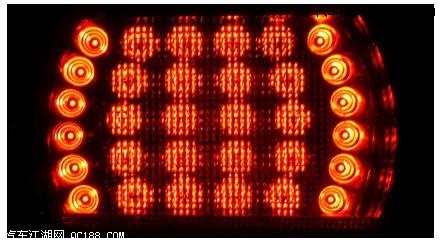LED车灯技术解读之英文版
 所属分类:车灯/照明
2013-8-31 22:54:55 推荐指数:
所属分类:车灯/照明
2013-8-31 22:54:55 推荐指数:
Several optics concepts have been developed for LED applications. Fig. 3 shows a solution with small parabolic reflectors. The reflectors collimate the light, the necessary light distribution is done by the use of additional optical elements in the outer lens or on the reflector surface (e.g. pillows, cylinder-shaped lenses).
KeyworDS:Rear lamp, night design, LED, parabolic reflector, homogeneity, luminance
The use of numerous small light sources allows for completely new opportunities for the design of lighting functions on a vehicle. Beside small incandescent lamps, which have disadvantages with respect to life time and heat, especially LEDs are well suited for this purpose, due to their well-known advantages (quick response, car lifetime, low heat, small built-in space, high efficiency etC.)
1 IntroductionIn the area of rear lamps, the proposition “only day-design counts” has been valid for a while. In recent years, the night appearance of rear lamps has gained significant attention. Today, also a homogeneous luminous distribution is considered to be of high value.
When using an incandescent lamp as light source, a homogeneous luminous appearance is only achievable, if size and shape of the particular application do not exceed certain limits. This limits the achievable homogeneity significantly. Applying LEDs allow for a much higher degree of freedom in designing individual functions. E.g., very ample or narrow surface areas can be illuminated homogeneously. It is also possible to vary the local illumination level in individual parts of a particular application, in order to emphasize certain design properties.
2 Typical Design of Rear Lamps with BulbsLimitations with respect to design occur in case of an optical design of a rear lamp with a single light source. To achieve a homogeneous illumination, certain geometrical conditions have to be obeyed. For example, in case of a laterally extended and narrow lamp, a homogeneous illumination is only possible, if the depth of housing is ACCORDingly high. Unfortunately, the available build-in depth is restricted in most cases, and problems with the metalization of the reflector may occur, if no countermeasures are taken to provide a sufficient reflectivity. In addition, a deep cavity causes a rather dark impression in unlit state. This often causes problems from a styling point of view. Thus, if the depth of the reflector has to be reduced due to one of these reasons, it results in a strong luminanceinhomogeneity. Regions in close proximity to the bulb will appear bright, whereas sections farther away from the light source will show only a slight glow (see Fig. 1 and Fig.2).
Figure 3: Reflector design for a LED-application with small parabolic reflectors
The following figures show some LED rear lamps where parabolic reflectors have been used. We succeeded in realising the styling requirements of the customer (esp. for the night design) by the use of LED light sources.
Figure 4: Replication of the daytime styling by following the contour of the lamp with the tail function (Rolls Royce Phantom).

Figure 5: The outer circles have a higher luminance than the inner section, realized by using LEDs with different brightness categories (Bentley Continental)

Figure 6: The optical elements for the outer LEDs are placed on the reflector, whereas the light distribution of the inner light sources is realized by pillows on an additional lens (BMW 3er Coupe u. Cabriolet).
Figure 7: Stop lamp function with scattering optics placed on the reflector faces (Mercedes-Benz CLS)

Figure 8: Stop Function with clear outer lens and reflector parabolas with additional circular scattering optics on the reflector face (Mercedes-Benz E-Class)With LEDs, another interesting optics concept can be realized: The LEDs are emitting downwards, thus illuminating a larger reflector. Thus a large reflector area can be illuminated effectively and homogeneously with a relatively small number of LEDs (see Fig.9 and Fig. 10)
Figure 9: Cross section of a lamp with downwards directed LED and large illuminated reflector
LEDs enable combinations of colour filters or outer lenses which are not feasible with bulbs. For example, red signal functions in combination with clear, grey or light red outer lenses can be realised without significant problems (of course, the attenuation of the grey or red outer lenses have to be taken into account when selecting the LEDs). As a more sophisticated task, also amber LEDs for turn signals can be installed in combination with red outer lenses. However, in that case the colour of the outer lens has to be selected accordingly, so that the amount of amber light transmitted by the red lens is large enough to fulfil the legal requirements (for illustration, see Fig. 11).
SummaryThe application of LED light sources for automotive lamps increases significantly the freedom in design forcar manufactures and set makers. A variety of new optical concepts become possible with the use of numerous small light sources with specific emission characteristics. Not only nearly arbitrarily chosen shapes and sizes can be illuminated homogeneously, but also dedicated luminance differences (e.g. for rings and Edges) can be realized. Also with respect to the choice of colours for outer lenses and optical elements the “toolbox” of the lamp designer increases significantly. Thus, with LEDs it is possible to realize an indistinguishable night time appearance of the car.
Colour Effects
2013年11月8日
ANW宽口数字雷达/专注道路预警安全 威仕特T5电子狗介绍
